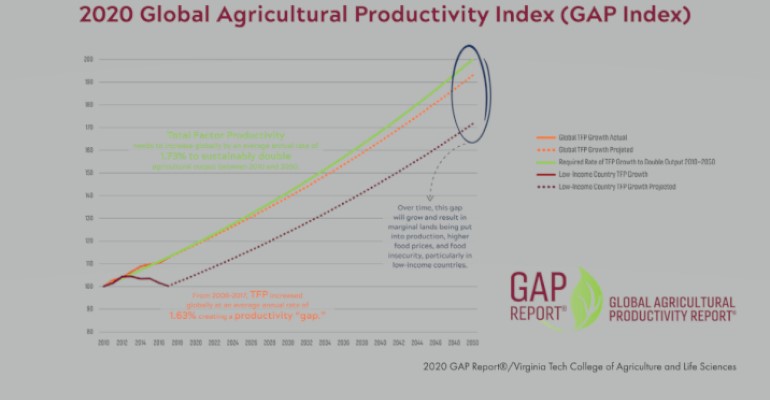Uneven ag productivity growth cause for concern
Productivity growth is “no regret” investment in time of pandemic.

Total factor productivity (TFP) growth varies widely across the world, leaving some countries more vulnerable to pandemic-scale outbreaks than others. The 2020 "Global Agricultural Productivity Report" (GAP Report) — “Productivity in a Time of Pandemics,” released by the Virginia Tech College of Agriculture & Life Sciences — raises concerns about the resilience of the agricultural systems in the face of pandemic-scale outbreaks that afflict people, crops and livestock.
New data from the U.S. Department of Agriculture's Economic Research Service presented in the GAP Report indicates that TFP is increasing globally by an average annual rate of 1.63%, unchanged from 2019. This is below the target of 1.73% required to double agricultural output through productivity growth from 2010 to 2050, as set by the report’s Global Agricultural Productivity Index (GAP Index).
TFP is a measure of efficiency, but it is also a strong indicator of the capacity to manage risk. In the case of livestock production, for example, healthy animals are more productive animals, generating more output per animal and needing less feed, water and other resources. Animal care practices to support productivity growth include vaccinations, protective housing, monitoring animals for signs of illness, isolating sick animals for treatment and eliminating breeding grounds for disease vectors like ticks. These same practices are essential to preventing and managing pandemic-style outbreaks of diseases such as an avian flu or African swine fever.
In high-income countries, TFP is increasing at 1.19% annually. The rate of TFP growth in North America has slowed to 1-2% annually since the turn of the century, the executive summary notes. “The slowdown coincides with reductions in public-sector agricultural research and development investments – the cornerstone of TFP growth. The technology pipeline, including CRISPR-Cas and artificial intelligence, holds the potential to provide a TFP boost in coming years. Yet, questions remain about which technologies consumers will accept,” the report states.
The traditional productivity powerhouses in North America and Europe have distinct advantages during pandemics. Advanced seed technologies, veterinary services and animal care and accurate agronomic and market data make it easier for producers to adapt in a time of crisis.
Access to affordable insurance and financing, as well as safety net programs, enable producers to absorb the worst financial impacts of a pandemic-scale crisis.
High-income countries have infrastructures for detection, management and eradication of pests and disease outbreaks in people, crops and livestock. Agricultural extension networks and robust research systems develop preventative tools and practices to keep pandemics at bay.
In upper-middle income countries, TFP is growing at an average annual rate of 2.37%, driven largely by China and Brazil.
In Brazil, precision agriculture, advanced seed technologies and improved livestock management systems have driven substantial TFP growth in feed grains and livestock production.
The Chinese government has prioritized the consolidation of agricultural land, creating opportunities for greater efficiency, especially in the wheat-growing regions. Mechanization services and fertilizer use efficiency have also improved, generating productivity gains. The TFP data do not yet reflect the impact of the African swine fever outbreak that has killed 40% of China’s swine population, but it will likely be significant.
Lower-middle income countries are also experiencing TFP growth above the global average at 2.19%, led by India, which has invested heavily in agricultural research and higher education.
The presence of advanced technologies and agricultural research systems in middle-income countries supports resilience in the face of pandemics. Nevertheless, there are significant vulnerabilities -- for example, underdeveloped or inefficient infrastructures for detection, management and eradication of pests and disease outbreaks.
TFP growth in low-income countries has dropped from 1.0% in 2019 to just 0.58% in 2020.
Under-funded agricultural research and extension programs in low-income countries leave producers highly vulnerable to disease and pest outbreaks. As an example, fall armyworm destroys 18 million tons of maize annually in Africa alone.
COVID-19 impacts on TFP growth are uncertain, but nevertheless, there are areas of concern. Travel restrictions and health anxieties have reduced the amount of agricultural labor available. As a result, fields have gone unplanted and unharvested. Disruptions to global and local supply chains are limiting access to essential inputs such as fertilizer, especially for smallholder farmers.
The theme of the 2020 GAP Report was inspired by the COVID-19 pandemic, but that is just the tip of the iceberg, according to Ann Steensland, who leads the GAP Initiative and is the author of the annual report.
“Agricultural producers grapple with disease and pest outbreaks with alarming frequency,” Steensland said. “While most of our current attention is on COVID-19, in East Africa, swarms of desert locust are decimating crops, wiping out a source of food and income for millions of people.”
The report’s findings are presented as part of a film, “Agricultural Productivity in a Time of Pandemics: Stories from the Front Lines,” featuring agricultural producers and experts from the U.S., Peru, Kenya, Burkina Faso and India.
The 2020 GAP Report and film are available on the website globalagriculturalproductivity.org.
About the Author(s)
You May Also Like




.png?width=300&auto=webp&quality=80&disable=upscale)
